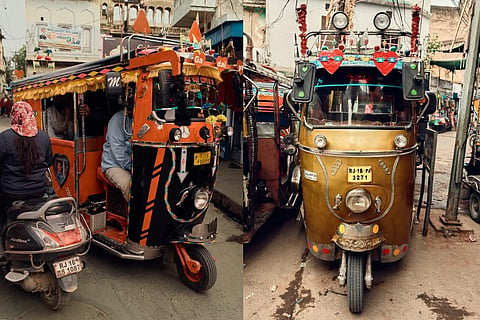
- HOMEGROWN WORLD
- #HGCREATORS
- #HGEXPLORE
- #HGVOICES
- #HGSHOP
- CAREERS
- ABOUT US
- CONTACT US

Known for its gorgeous murals, the Shekhawati region in Rajasthan is often called “the world’s largest open-air art gallery”. The buildings and havelis in the area are impeccably decorated, adorned with paintings that date back to the 20th, 19th, and in some cases, even 17th centuries. One drive through the region makes it abundantly clear that art is integral to Shekhawati’s culture and history.
Photographer Archit Sharma was passing through Nawalgarh, a city in the Jhunjhunu district of Shekawati, when he realised that the region’s art isn’t just lining their roads, but cruising down them. Born in Jaipur and hailing from New Delhi Sharma was in the area to visit heritage sites with his uncle when a glossy, bright red auto rickshaw caught his eye. We’re all familiar with the classic auto designs, used to seeing all-black with yellow-lined windshields or green-and-yellow rickshaws zipping through our streets. However, in Nawalgarh, Sharma discovered a new world of custom-designed autos, painting the area with a rainbow of mobile works of art.
Sharma documented these unique auto rickshaws in his new photo series, ‘Nawalgarh Coupes.’ His photography captures the efforts of the region’s artistic auto drivers, showing off their various custom-designs. There’s no uniformity amongst these autos. One is coated in a metallic gold, embellished with silver fish decals and faux Audi logos by its headlights and a crown of brightly coloured hearts, flowers, and stars across the top of its hood. Another looks royal, with hints of baby blue paint and rococo motifs used to elevate its look. A particularly fascinating ocre-coloured auto boasts revolutionary Bhagat Singh’s face in a heart-shaped frame across its side and guitar cutouts in its interior.
Each of these autos acts as a representation of each driver’s individuality, allowing the region’s art tradition to continue through a new form. In Nawalgarh, public transportation also acts as an expression of personal identity. Sharma was inspired by how “The craftsmanship and creativity of the region has persisted, though transitioned to a contemporary form, within the reach of more people.”
Nawalgarh Coupes encompasses the beauty of individual expression, particularly when uniformity is what we’ve all come to expect. Their art keeps the Shekhawati region’s creative spirit alive, showing us that beauty can be found in even the most unexpected of places.
I saw livelihood - inspired by what came before them. The grandeur of Nawalgarh, the heritage, decorated with personalities so unique that I felt the need to preserve it before it disappeared. This project is my ode to design in its truest form.
Archit Sharma for Homegrown
If you enjoyed reading this, here’s more from Homegrown:
Priya Mani’s 'Encyclopaedia Of Indian Food' Maps The Cultural Narratives Of Indian Food
Resistance Without Romance: The Legacy Of Sudhir Patwardhan's Postmodern Cityscapes
Becoming A Butterfly: A Photoseries Connecting Climate Change To Cultural Erasure
